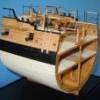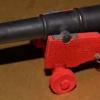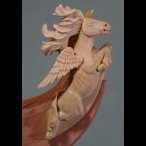-
Posts
13,092 -
Joined
-
Last visited
Reputation Activity
-
 druxey got a reaction from robin b in Princess royal 1780's British merchant ship
druxey got a reaction from robin b in Princess royal 1780's British merchant ship
That information is much more helpful! Illustrated below is very much like what her appearance would have been. The plan shows a slightly later and larger ship, after conversion in the navy. Take away all those gun ports and the barricades along the upper deck, replacing them with open rails, and you will have a pretty good idea of what your Princess Royal looked like. (This drawing is from the Royal Museums Greenwich collection, reproduced under the Creative Commons licence.)
-
 druxey got a reaction from dvm27 in Princess royal 1780's British merchant ship
druxey got a reaction from dvm27 in Princess royal 1780's British merchant ship
That information is much more helpful! Illustrated below is very much like what her appearance would have been. The plan shows a slightly later and larger ship, after conversion in the navy. Take away all those gun ports and the barricades along the upper deck, replacing them with open rails, and you will have a pretty good idea of what your Princess Royal looked like. (This drawing is from the Royal Museums Greenwich collection, reproduced under the Creative Commons licence.)
-
 druxey reacted to AON in HMS Bellerophon 1786 by AON – scale 1:64 – 74-gun 3rd Rate Man of War - Arrogant-Class
druxey reacted to AON in HMS Bellerophon 1786 by AON – scale 1:64 – 74-gun 3rd Rate Man of War - Arrogant-Class
I also worked on my new fangled Plexiglas goose-necked shaped support plates.
The Plexiglas was taped (I used painters tape) and the shape traced onto it.
The sheet was clamped down securely and the shape cutout using a special Plexiglas cutting blade.
If you don’t move quickly enough the plastic melts and sticks back together or leaves a blob of material on the edge that I found was easily removed.
The edge was then filed smooth and sanded (various papers, scotch brite pad, micro fine pad).
I then polished the edge.
The final step was to wash the piece in warm soapy water. I used Dawn dish soap. If it’s gentle enough for oil soaked water fowl it is good enough for my work. (Never use glass cleaner or such products on Plexiglas).
Finally I cut out my slots in the wood frame, installed the T-bolts to the table and assembled it in place.
Easy, right?
Well here is what went wrong…
By the time I worked on the second sheet and frame things started to go south. One of the slotted wood uprights on the second frame was installed backwards (slots out) and the space between the two slotted uprights was a wee bit tighter so my second sheet is about 1/16” too wide and needs to be filed down to fit… hence no pictures of the bow support assembly as yet.
-
 druxey reacted to AON in HMS Bellerophon 1786 by AON – scale 1:64 – 74-gun 3rd Rate Man of War - Arrogant-Class
druxey reacted to AON in HMS Bellerophon 1786 by AON – scale 1:64 – 74-gun 3rd Rate Man of War - Arrogant-Class
Saturday, 25 April 2015
While merrily working on my frame templates I suddenly realized I was putting in upper scarph joints that likely overlapped the gun ports and sills.
I drew in all the gun ports and sills as measured off the plan and the contract.
This showed many of my upper scarph joints to be in or overlapping the holes.
These were removed and/or relocated.
Below is a small sampling (I turned off all other frames) ... you can see the joints in the one frame (all others are turned off to make it clearer)
-
 druxey got a reaction from trippwj in Seeking information on determining load waterline
druxey got a reaction from trippwj in Seeking information on determining load waterline
Hi, Wayne. I was actually given a copy of this Occasional Publication No. 6 last month by a fellow modelmaker. He was dispersing the contents of a deceased model maker's workshop and knew I had an interest in "that early stuff". I'd never come across a copy before and was working my way through the text yesterday.
-
 druxey reacted to SJSoane in HMS Bellona 1760 by SJSoane - Scale 1:64 - English 74-gun - as designed
druxey reacted to SJSoane in HMS Bellona 1760 by SJSoane - Scale 1:64 - English 74-gun - as designed
druxey, you are right. I wonder if I would have taken on building a 74 all those many years ago, if I had fully thought through just how many guns need to be constructed.
As I was patiently making 28 parts of something the other day, I began thinking about the gun carriage craftsmen in Chatham who might have made the same parts over and over for their entire lives. Now that would drive someone to drink, meade I presume!
Mark
-
 druxey reacted to trippwj in Seeking information on determining load waterline
druxey reacted to trippwj in Seeking information on determining load waterline
Thank you, druxey. That is useful - I have been searching (unsuccessfully) for a copy of this book. Please let me know if you come across any!
Thus far I have only been able to gain a small understanding from Barker's narrative published as Barker, Richard. “Fragments From The Pepysian Library.” Revista Da Universidade de Coimbra XXXII (1985): 161–78. http://home.clara.net/rabarker/Fragments83txt.htm.
He notes the following, which really keyed my interest!
One of the more intriguing aspects of the numerical work in Fragments is the frequent calculation of sectional areas of moulds below the depth by Baker, usually linked with the product breadth x depth, effectively giving a prismatic coefficient. Taken with Bourne’s Treasure for Travellers on mensuration of ships lines and waterplanes, from which it is perfectly clear that Bourne and his contemporaries knew how to measure displacement tonnage at any selected draught, either as a paper exercise or with the use of models, it is difficult to avoid the conclusion that Deane’s contribution to the principles at least of determining displacement (and thence draught at launching) has been overstated. It appears to rest entirely on Pepys’ record of what Deane told him. Even Deane is not explicit in his Doctrine about his methods in the procedures covered now by Simpson’s Rules, and begs a number of question in his treatment. Just what Baker was doing with prismatic coefficients and immersed (?) areas of sections remains a mystery, but the practice should at least be credited to his era. It is at least possible that the incentive for both Baker and Wells was the search for a satisfactory tonnage rule. Baker apparently changed his method about 1582: Wells was heavily involved in a Commission to investigate tonnage rules in 1626.
-
 druxey got a reaction from Mark P in Seeking information on determining load waterline
druxey got a reaction from Mark P in Seeking information on determining load waterline
This comes a little late to the table, but I have just come cross a description in A Treatise of Shipbuilding, circa 1620-25, as reprinted, edited and annotated by W. Salisbury and R.C. Anderson (Society for Nautical Research Occasional Publications No. 6, London 1958). It reads as follows (pages 26-27):
The next thing to be drawn in this plane of length and depth is the swimming line, which is a principal thing to be regarded for the good qualities of the ship. From that line are set off the decks and ports for the ordnance, higher or lower as we will have them lie to pass; therefore of right there should be marks made on the ship's side to direct the mariner always to keep her in that trim, neither to sink her deeper nor let her swim shoaler. The depth of this line is taken off the midship bend, for where the two upper sweeps intersect each other with respect to the thickness of the plank (which intersection is easily found by drawing a straight line through the centres of the upper sweep and futtock sweep), from thence to the ground line is the true depth of the swimming line. Which depth being marked upon the midship line and upon each perpendicular of the upper rising, draw a straight line from stem to stern. So you have the swimming line desired.
-
 druxey reacted to SJSoane in HMS Bellona 1760 by SJSoane - Scale 1:64 - English 74-gun - as designed
druxey reacted to SJSoane in HMS Bellona 1760 by SJSoane - Scale 1:64 - English 74-gun - as designed
Hi everyone,
Here are some images of cutting the quoin handle with the Vanda-Lay duplicator.
As you can see in the last photo, a template holder clamps onto the tailstock, and the cutting head and follower is bolted onto the Sherline Y table. You have to unbolt the brass nut on the X axis lead screw, so the bed can move freely without using the handwheel.
The idea is to slide the table in the X direction with your right hand, and push in the follower with your left hand, trying to trace the template as smoothly as possible. After a few tries, I got very reliable duplicates every time.
Now, I did learn that I had to loosen the gib on the X axis, so the table would move very smoothly. I also used silicon grease on the ways, and graphite powder for the follower and cutter. Things really do need to move smoothly without any binding.
Also, the cutter does need to be aligned precisely at or just below the centerline of the lathe. It took a little fiddling to get the cutter at the right height and at the right distance in.
I fed a long strip of wood through the lathe, and simply moved it forward each time once I had cut off the previous handle. The masking tape at the end keeps the wood from bouncing around when the lathe is turned on.
I have had this duplicator for years, but I had never used it until now; I believe there is an updated version from Vanda Lay. I can confirm that it works very well, once everything is tuned.
The other photos show using a razor saw to cut off the handles when the lathe is turned off; these would fly for sure if using a cut-off tool.
And one more photo shows the jig for drilling the handle hole in the ends of the quoins.
Mark
-
 druxey got a reaction from robin b in Princess royal 1780's British merchant ship
druxey got a reaction from robin b in Princess royal 1780's British merchant ship
A little more information would be helpful. Have you any idea of her size or tonnage, for instance?
-
 druxey reacted to Rob Wood in Specifications for Construction of U.S. Navy Ship Models
druxey reacted to Rob Wood in Specifications for Construction of U.S. Navy Ship Models
I think I'm at a point in my life, maybe due to age, where I think a lot more about longevity and sustainability than I did when I was younger. I did build a model that was displayed (briefly) at the Smithsonian Air & Space museum, so maybe that experience has helped shape my thinking now.
I doubt seriously that any model I build in the productive model building years remaining to me will find its way into a museum of the caliber we've been discussing, but I certainly don't want any model I build to delaminate 10 or 12 years from now. I like the idea of building things that last, whether a model, a piece of furniture, or a friendship. CA glue has its uses, for sure, and the main reason I have used it - and I'm sure it's a common one - is speed. I build combat warship models, and would never have a ship ready for the next event if I didn't have CA for repairs.
But what I think we're talking about in this discussion are static display models. I can see using CA or other time-saving adhesives if there's some kind of deadline, but otherwise, it doesn't make a lot of sense to me. What is the logic behind speeding up the build, if the experience of the build itself is the main reason behind the project?
Rob
-
 druxey reacted to Rob Wood in Specifications for Construction of U.S. Navy Ship Models
druxey reacted to Rob Wood in Specifications for Construction of U.S. Navy Ship Models
Keep in mind that the information that I posted here that started the thread was narrowly concerned with model ship standards of the U.S. Navy. According to Dana Wegner, both the Navy and the Smithsonian follow these guidelines. To me, it's common sense to define what "museum quality" means to the Navy and Smithsonian curators. One merely needs to visit those museums for an education on what it means within this narrow scope.
On the subject of "modern" construction materials and adhesives: I have certainly had some CA wood joints fail over the years, and even more metal-to-metal and metal-to-wood joints delaminate. As to why, I have not undertaken a scientific analysis, mainly because I don't have the knowledge or time. The guidelines above don't say that a CA joint won't last 100 years, just that there is no empirical evidence to argue that it will. To further complicate it, there is no standard by which CA is made. Different formulas have different characteristics, and there is no way to predict either its holding ability or its chemical stability over time.
I will relate one personal anecdote about one adhesive, though. I used contact cement to affix the finished layer of planks to the hull per the instructions in the Swift Virginia Pilot Boat kit. The hull was beautiful for around 12 years, when - one by one - the planks began to peel off the substrate. It all now needs to be stripped down and re-planked.
And this is the point behind the guidelines. Most museums are understaffed. No one wants to take a ship model out of its glass case and rebuild it. Merely removing a model from its case exposes it to a slew of new environmental variables, and even touching the rigging of an old model can be enough to break it.
Rob
-
 druxey got a reaction from augie in HMS Pegasus 1776 by Trussben - 1:48 - Swan-class sloop based on TFFM
druxey got a reaction from augie in HMS Pegasus 1776 by Trussben - 1:48 - Swan-class sloop based on TFFM
Looks like a good strategy, Ben. Those cant frames look lovely.
-
 druxey got a reaction from mtaylor in HMS Pegasus 1776 by Trussben - 1:48 - Swan-class sloop based on TFFM
druxey got a reaction from mtaylor in HMS Pegasus 1776 by Trussben - 1:48 - Swan-class sloop based on TFFM
Looks like a good strategy, Ben. Those cant frames look lovely.
-
 druxey reacted to dvm27 in HMS Pegasus 1776 by Trussben - 1:48 - Swan-class sloop based on TFFM
druxey reacted to dvm27 in HMS Pegasus 1776 by Trussben - 1:48 - Swan-class sloop based on TFFM
That's the way to do it, Ben. Be extra careful around them once installed. One inadvertent swipe with an elbow will snap them off (I know from experience).
-
 druxey got a reaction from Canute in At what point of modifications would a kit become "Kit Bashed"
druxey got a reaction from Canute in At what point of modifications would a kit become "Kit Bashed"
This thread seems to have generated a lot of interest and comment. Let me see if I've got it right:
Kit - built straight out of a box using the manufacturer's instructions (if you can understand them!)
Modified kit - as above, but with additional details that have been purchased, such as photo-etched sheets, rope or blocks.
Kit-bashed - one or more kits that have been cobbled together to represent a different subject than the kit(s)
Semi-scratch - from based on a kit, but heavily modified using parts made by the builder, to builder fabricated with some commercial parts
Scratch - completely fabricated from raw materials by the builder, no commercial parts
Museum quality - an over-used and hence now meaningless term (Yeah, I'm sticking my neck out on this one!)
The 'semi-scratch' definition seems to be the broadest, if my summary is correct. Should there be sub-sets in this category?
-
 druxey got a reaction from mtaylor in At what point of modifications would a kit become "Kit Bashed"
druxey got a reaction from mtaylor in At what point of modifications would a kit become "Kit Bashed"
This thread seems to have generated a lot of interest and comment. Let me see if I've got it right:
Kit - built straight out of a box using the manufacturer's instructions (if you can understand them!)
Modified kit - as above, but with additional details that have been purchased, such as photo-etched sheets, rope or blocks.
Kit-bashed - one or more kits that have been cobbled together to represent a different subject than the kit(s)
Semi-scratch - from based on a kit, but heavily modified using parts made by the builder, to builder fabricated with some commercial parts
Scratch - completely fabricated from raw materials by the builder, no commercial parts
Museum quality - an over-used and hence now meaningless term (Yeah, I'm sticking my neck out on this one!)
The 'semi-scratch' definition seems to be the broadest, if my summary is correct. Should there be sub-sets in this category?
-
 druxey got a reaction from Trussben in HMS Pegasus 1776 by Trussben - 1:48 - Swan-class sloop based on TFFM
druxey got a reaction from Trussben in HMS Pegasus 1776 by Trussben - 1:48 - Swan-class sloop based on TFFM
Looks like a good strategy, Ben. Those cant frames look lovely.
-
 druxey got a reaction from jbshan in At what point of modifications would a kit become "Kit Bashed"
druxey got a reaction from jbshan in At what point of modifications would a kit become "Kit Bashed"
This thread seems to have generated a lot of interest and comment. Let me see if I've got it right:
Kit - built straight out of a box using the manufacturer's instructions (if you can understand them!)
Modified kit - as above, but with additional details that have been purchased, such as photo-etched sheets, rope or blocks.
Kit-bashed - one or more kits that have been cobbled together to represent a different subject than the kit(s)
Semi-scratch - from based on a kit, but heavily modified using parts made by the builder, to builder fabricated with some commercial parts
Scratch - completely fabricated from raw materials by the builder, no commercial parts
Museum quality - an over-used and hence now meaningless term (Yeah, I'm sticking my neck out on this one!)
The 'semi-scratch' definition seems to be the broadest, if my summary is correct. Should there be sub-sets in this category?
-
 druxey reacted to Trussben in HMS Pegasus 1776 by Trussben - 1:48 - Swan-class sloop based on TFFM
druxey reacted to Trussben in HMS Pegasus 1776 by Trussben - 1:48 - Swan-class sloop based on TFFM
The side counter timbers are being installed in the next picture, the wooden square you see was made to be exactly 12"3' wide and the same height as the toptimber height from the plan, this was then taped down to the build board exactly 5"3' back from the aft perpendicular as per TFFM.
I am hoping that doing it this way will ensure the these counter timbers are in the exact right place.
Ben
-
 druxey reacted to uss frolick in At what point of modifications would a kit become "Kit Bashed"
druxey reacted to uss frolick in At what point of modifications would a kit become "Kit Bashed"
Bad cop! No donut!
-
 druxey reacted to ccoyle in At what point of modifications would a kit become "Kit Bashed"
druxey reacted to ccoyle in At what point of modifications would a kit become "Kit Bashed"
Bad dog! Bad dog! No biscuit!
-
 druxey reacted to realworkingsailor in At what point of modifications would a kit become "Kit Bashed"
druxey reacted to realworkingsailor in At what point of modifications would a kit become "Kit Bashed"
Don't get me wrong, I'm not judging anyone or anything. I just feel it's time to expand the vocabulary a little bit to help people better understand the goals of other model builders. And maybe help bring model shipbuilding in line with other hobbies terminology. Might even help a few newcomers along the way.
Andy
-
 druxey reacted to Canute in At what point of modifications would a kit become "Kit Bashed"
druxey reacted to Canute in At what point of modifications would a kit become "Kit Bashed"
As another with a model railroader (MRR) background, I agree with Andy. It's important to define, if we are going to an IPMS or NMRA event, when you have to categorize the models for a contest. As an occasional contest judge and model evaluator for model railroading, I've been in the cross hairs of some irate contestants. It's a tough spot to be in. I try to avoid contest judging nowadays, but still help to evaluate folks' work, normally in their homes. Can't haul your layout in to my place to look at track-work or scenery, can you?
We don't judge here, we support and offer constructive criticism. Big reason why I'm here. For our purposes and usage, super-detailing and kit bashing are equally valid terms and the MRRs here will occasionally slip and call these kit-bashes superdetailing. Let's not fall on our swords over a little semantic issue. C'est la vie!
-
 druxey reacted to realworkingsailor in At what point of modifications would a kit become "Kit Bashed"
druxey reacted to realworkingsailor in At what point of modifications would a kit become "Kit Bashed"
I don't see why there's all this so-called "fuzzy" or grey area.
If you start with "A" and end up with a highly detailed and hyper accurate "A" (even if you had to significantly re-build or modify it), it should be considered super-detailing.
If you start with "A" and end up with "B" OR if you start with "A" and "B" and combine them to get "C" it's kit bashing.
Andy










